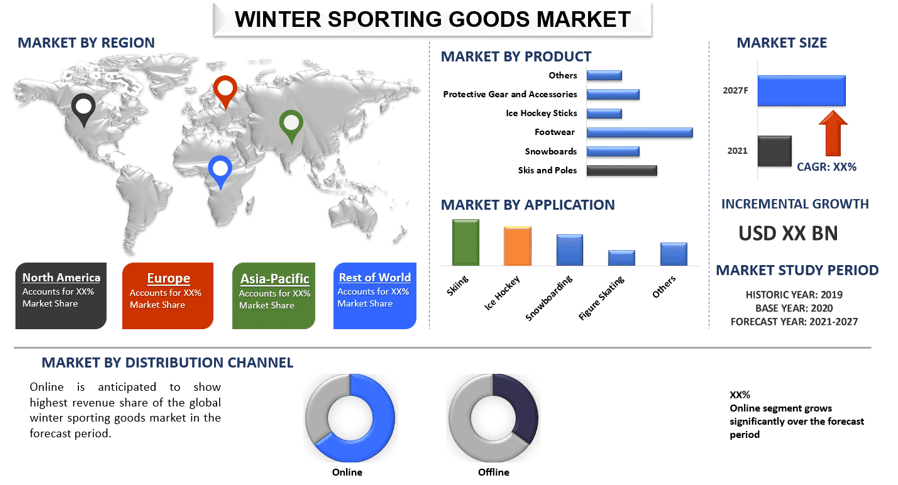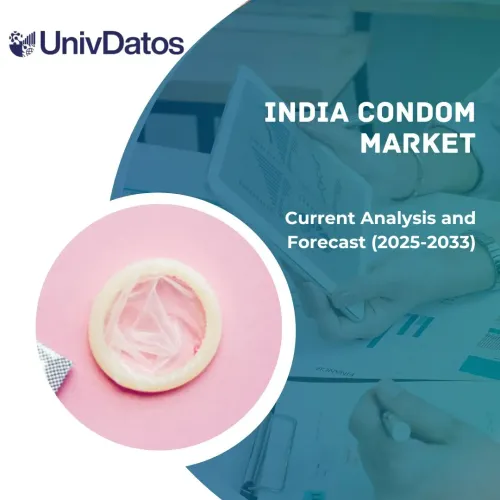- Home
- About Us
- Industry
- Services
- Reading
- Contact Us
Winter Sporting Goods Market: Current Analysis and Forecast (2021-2027)
Emphasis on Product (Skis and Poles, Snowboards, Footwear, Ice Hockey Sticks, Protective Gear and Accessories, Others); Application (Skiing, Ice Hockey, Snowboarding, Figure Skating, others); Distribution Channel (Online and Offline); Region/Country

Winter Sporting Goods Market is expected to grow at a CAGR of around 3% over the forecast period (2021-2027). The Winter Sporting Goods Market is primarily driven by the factors such as rising popularity of winter sports in developing economies and rising number of participants in winter sports from both advanced and emerging economies.
The rising popularity of outdoor activities including snow sports among consumers, because of the growing awareness regarding these sports mental and physical benefits, is driving the winter sporting goods demand, thereby supporting this market’s growth. The growing consumer interest in nature-based sports that offer leisure, as well as competitiveness, has been promoting the demand for winter sports products including sleds and tubes. Sports enthusiasts in the advanced economies are focusing on making winter sports a mainstream profession which acts as a vital factor escalating the market growth.
Some of the major players operating in the market include Tube Pro, Inc., Airhead Sports Group, L.L. Bean, Agit Global, Inc., Emsco Group, Slippery Racer, Franklin Sports Inc., Gizmo Riders, Surf 9 LLC, Zipfy, etc. Several M&A’s along with partnerships have been undertaken by these players to boost their presence in different regions.
Insights Presented in the Report
“Amongst Product, Footwear segment dominated the market in 2020”
Based on Product, the market is segmented into Skis and Poles, Snowboards, Footwear, Ice Hockey Sticks, Protective Gear and Accessories and Others. Of the different product segments, the footwear segment leads the global market, accounting for over half of the overall market share in 2020. Advancements in technology have given rise to innovations in wearable gear. Intelligent gear such as insoles that act as a personal ski instructor, and textiles that regulate body temperature, are dictating the startup scene as well as product launches in the skiing space.
“Amongst Application, Skiing segment dominated the market in 2020.”
Based on Application, the Winter Sporting Goods Market is segmented into Skiing, Ice Hockey, Snowboarding, Figure Skating and Others. The Skiing segment contributed the maximum market to the Winter Sporting Goods Market. The increasing concern among consumers for a healthy lifestyle coupled with the rising acceptance of various winter sports activities, such as skiing, snowboarding, cross-country skiing, sledding, and ice skating, especially in countries with cold weather like the U.S., Canada, Germany, Sweden, France, and Austria, has increased the popularity of winter sports.
“Amongst Distribution Channel, Online segment holds significant market share in 2020.”
Based on Distribution Channel, the Winter Sporting Goods Market is segmented into Online and Offline. Online segment holds the highest share in the Winter Sporting Goods Market. The growing popularity of e-commerce platforms and the increasing preference for online shopping have compelled manufacturers to lean on online distribution for better visibility and a wider consumer reach. Several manufacturers are increasingly focusing on implementing the direct-to-consumer approach to generate more sales through their online retail platforms.
“North America represents as the largest market.”
For a better understanding of the market adoption of Winter Sporting Goods, the market is analyzed for the countries such as North America (US, Canada, Rest of North America), Europe (Germany, United Kingdom, France, Italy, Spain, Rest of Europe), Asia-Pacific (China, Japan, India, Australia, Rest of Asia- Pacific), & Rest of World. North America dominated the market in 2020. North America dominates the winter sports equipment market due to presence of various sports enthusiasts and an increasing number of winter sports participants. Sports enthusiasts in the advanced economies are focusing on making winter sports a mainstream profession which acts as a vital factor escalating the market growth. This is boosting the sales of sporting goods massively and helping the market grow organically without any major push.
Reasons to buy this report:
- The study includes market sizing and forecasting analysis validated by authenticated key industry experts
- The report presents a quick review of overall industry performance at one glance
- The report covers an in-depth analysis of prominent industry peers with a primary focus on key business financials, product portfolio, expansion strategies, and recent developments
- Detailed examination of drivers, restraints, key trends, and opportunities prevailing in the industry
- The study comprehensively covers the market across different segments
- Deep dive regional & country-level analysis of the industry
Customization Options:
Winter Sporting Goods Market can further be customized as per the requirement or any other market segment. Besides this, UMI understands that you may have your own business needs, hence feel free to connect with us to get a report that completely suits your requirements.
Table of Content
Analyzing the historical market, estimation of the current market, and forecasting the future of the Winter Sporting Goods Market were the three major steps undertaken to create and analyze the adoption of Winter Sporting Goods across various regions globally. Exhaustive secondary research was conducted to collect the historical market numbers and estimate the current market size. Secondly, to validate these insights, numerous findings and assumptions were taken into consideration. Moreover, exhaustive primary interviews were conducted, with industry experts across the value chain of the industry. Post assumption and validation of market numbers through primary interviews, we employed a top-down/bottom-up approach to forecast the complete market size. Thereafter, market breakdown and data triangulation methods were adopted to estimate and analyze the market size of segments and sub-segments the industry pertains to. Detailed methodology is explained below.
Seek More Details About Research Methodology
Analysis of Historical Market Size
Step 1: In-Depth Study of Secondary Sources:
Detailed secondary study was conducted to obtain the historical market size of the Winter Sporting Goods through company internal sources such as annual report & financial statements, investor presentations, press releases, etc., and external sources including journals, news & articles, government publications, competitor publications, sector reports, third-party database, and other credible publications.
Step 2: Market Segmentation:
After obtaining the historical market size of the Winter Sporting Goods, we conducted a detailed secondary analysis to gather historical market insights and share for different segments & sub-segments for major regions. Major segments included in the report are by product, application, and distribution channel. Further regional & country-level analyses were conducted to evaluate the overall adoption of the Winter Sporting Goods Market in the global context.
Step 3: Factor Analysis:
After acquiring the historical market size of different segments and sub-segments, we conducted a detailed factor analysis to estimate the current market size. Further, we conducted factor analysis using dependent and independent variables such as rising popularity of winter sports in developing economies and rising number of participants in winter sports from both advanced and emerging economies. Historical trends and their year-on-year impact on the market size and share was analyzed. Demand and supply side scenario was also thoroughly studied.
Current Market Size Estimate & Forecast
Current Market Sizing: Based on actionable insights from the above 3 steps, we arrived at the current market size, key players in the Market, and market shares of the segments and company. All the required percentage split, and market breakdowns were determined using the above-mentioned secondary approach and were verified through primary interviews.
Estimation & Forecasting: For market estimation and forecast, weights were assigned to different factors including drivers & trends, restraints, and opportunities available for the stakeholders. After analyzing these factors, relevant forecasting techniques i.e., top-down/bottom-up approach was applied to arrive at the market forecast to 2027 for different segments and subsegments across the major regions globally. The research methodology adopted to estimate the market size encompasses:
- The industry’s market size, in terms of value (US$)
- All percentage shares, splits, and breakdowns of market segments and sub-segments
- Key players in the Winter Sporting Goods Market in terms of products & services offered. Also, the growth strategies adopted by these players to compete in the fast-growing market.
Market Size and Share Validation
Primary Research: In-depth interviews were conducted with the Key Opinion Leaders (KOLs) including Top Level Executives (CXO/VPs, Sales Head, Marketing Head, Operational Head, and Regional Head, Country Head, etc.) across major countries. Primary research findings were then summarized, and statistical analysis was performed to prove the stated hypothesis. Inputs from primary research were consolidated with secondary findings, hence turning information into actionable insights.
Split of Primary Participants in Different Regions

Market Engineering
Data triangulation technique was employed to complete the overall market estimation and to arrive at precise statistical numbers of each segment and sub-segment of the Winter Sporting Goods Market. Data was split into several segments & sub-segments post studying various parameters and trends in the areas of product, application, and distribution channel for the major country/region globally.
The main objective of the Winter Sporting Goods Market Study
The current & future market trends of Winter Sporting Goods were pinpointed in the study. Investors can gain strategic insights to base their discretion for investments from the qualitative and quantitative analysis performed in the study. Current and future market trends would determine the overall attractiveness of the market at a regional & country level, providing a platform for the industrial participant to exploit the untapped market to benefit as a first-mover advantage. Other quantitative goals of the studies include:
- Analyze the current and forecast market size of Winter Sporting Goods in terms of value (US$). Also, analyze the current and forecast market size of different segments and sub-segments
- Segments in the study include of product, application and distribution channel
- Analyze the current and forecast market size of the Winter Sporting Goods for the major regions & countries
- Major regions studied in the report include North America (United States, Canada, Rest of North America), Europe (Germany, United Kingdom, France, Italy, Spain, Rest of Europe), Asia Pacific (China, Japan, India, Australia, Rest of Asia- Pacific), and Rest of World
- Company profiles of the Winter Sporting Goods Market players and the growth strategies adopted by them to sustain in the fast-growing market
- Deep dive regional & country level analysis of the industry
Related Reports
Customers who bought this item also bought










